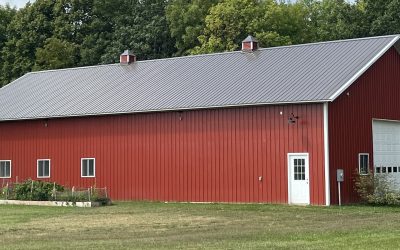Roofing installation is a critical process in the construction of any building. It involves the application of materials to provide shelter from the elements, ensuring that the internal structure and inhabitants are shielded from weather conditions. The process varies depending on the type of roofing material being installed, including but not limited to shingles, metal, tiles, and more. Besides the material, the installation also depends on the roof design, the climate of the area, and the specific requirements of the building. Understanding the basics of roofing installation is paramount for anyone looking to embark on a construction project, whether it’s a simple shed or a multi-story residential building.
Understanding the basics of roofing installation holds immense importance for several reasons. Firstly, it enables homeowners to make informed decisions about the most suitable roofing materials and designs for their homes. It also equips them with the knowledge to supervise the installation process and ensure that it adheres to the best practices and standards. Additionally, a solid understanding of roofing installation basics can help identify problems early, saving one from potentially costly repairs or replacements in the future. It also empowers homeowners to maintain their roofs effectively, thereby extending the lifespan and maintaining the structural integrity of the roof. In essence, comprehending the rudiments of roofing installation can save time, and money, and provide peace of mind.
Types of Roofing Materials
Understanding the basics of roofing installation also involves getting to know the various types of roofing materials available on the market. Each roofing material has its unique set of characteristics, advantages, and disadvantages.
Common Types of Roofing Materials
The most commonly used materials include asphalt shingles, metal, slate, clay, and concrete tiles, as well as wood shakes. Asphalt shingles are by far the most popular roofing material due to their affordability, ease of installation, and wide range of color options. Asphalt shingle roofs are a top choice for homeowners seeking a durable and cost-effective roofing solution. However, they have a shorter lifespan compared to other materials and are not very eco-friendly. Metal roofs, on the other hand, are durable, fire-resistant, and recyclable, but they can be more expensive and require professional installation. Slate and clay tiles offer a unique aesthetic appeal, and longevity, and are fire-resistant. However, they are heavy and may require additional support, making them more suitable for new constructions than for older homes. Wood shakes provide a natural look and excellent insulation but require high maintenance and are prone to fire and termites.
Choosing the Right Roofing Material
Choosing the right roofing material requires consideration of various factors. Your geographical location plays a significant role in this choice. For instance, metal roofs are excellent for areas prone to wildfires due to their fire resistance, while slate and clay tiles are ideal for warmer climates as they help keep homes cool. The architectural style of your home, your budget, and your personal preference also influence your choice of roofing material.
In conclusion, understanding the types of roofing materials, their benefits, drawbacks, and suitability based on your location and needs, is crucial in making an informed decision. This knowledge will not only help in selecting the right material but also in ensuring its proper installation and maintenance.
Tools Required for Roofing Installation
Having explored the various types of roofing materials and the factors that influence their selection, it’s crucial to delve into the tools necessary for the actual roofing installation process. An array of essential tools are required for roofing installation, each designed to cater to the specific demands of the task at hand. For example, a roofing nailer is used to fasten roofing materials, while a shingle remover, also known as a roofing shovel, facilitates the removal of old shingles. Other critical tools include a hammer, roofing hatchet, utility knife, chalk line, and tape measure. A ladder is also indispensable for accessing the roof.
Safety
Safety is paramount during roofing installation, hence the need for appropriate safety gear. Safety equipment includes a hard hat to protect against falling debris, a safety harness to prevent falls, safety glasses for eye protection, and gloves to guard hands against sharp objects and extreme temperatures. Non-slip boots can also provide added security on slippery roofs.
Understanding the Functions and Limitations of Different Tools
The tools for roofing installation are not merely about owning them but knowing how to use these tools effectively and safely. Therefore, understanding their functions and limitations is crucial. For instance, when using a roofing nailer, ensure you are holding it firmly to prevent recoil injuries. Additionally, always keep your hands clear from the nailer’s firing line. When using a ladder, it should be placed on firm and level ground, and one should always maintain a three-point contact (two hands and one foot, or two feet and one hand) when climbing or descending.
In conclusion, having the right tools and safety equipment, coupled with the knowledge of how to use them effectively and safely, can make the roofing installation process smoother and safer. Remember, the roofing material chosen, whether it is asphalt shingles, metal, slate, clay, concrete tiles, or wood shakes, will influence the type of tools required for the job.
Steps in Roofing Installation
Preparing the Existing Roof for the New Installation
The roofing installation process is a complex task that requires meticulous attention to detail and a solid understanding of construction concepts. The first step begins with preparing the existing roof for the new installation. This involves removing old shingles, cleaning the roof deck, and inspecting it for signs of damage. If any damage is found, it needs to be addressed before proceeding.
Installing the Underlayment
Once the roof deck is ready, underlayment is installed to provide a secondary barrier against water and wind. This is followed by the installation of drip edge, flashing, and shingles, each requiring careful placement and secure fastening. The final step in the roofing installation process is the clean-up and disposal of waste material.
Common Mistakes to Avoid
During this process, there are several common mistakes to avoid. One of the most frequent errors is incorrect nailing. This can lead to shingles becoming loose or falling off. It’s important to remember that each shingle should be secured with at least four nails, all of which need to be driven straight and flush with the shingle surface. Another common mistake is improper installation of underlayment or flashing, which can lead to leaks and subsequent damage.
The Importance of Planning
To ensure a successful roofing installation, planning is paramount. Start by choosing the right time of year for the job. Ideal conditions are a clear, sunny day with little to no wind. Additionally, always measure twice and cut once to ensure accuracy and minimize waste. Lastly, never rush the process. While it may be tempting to speed through the installation, roofing is a task that requires patience and precision for a successful outcome.
Hiring a Professional Roofing Contractor
Why Hiring a Professional Roofing Contractor is a Viable Option
Transitioning from understanding the basics of roofing installation, it becomes clear why hiring a professional roofing contractor is a viable option. These professionals come armed with years of experience, in-depth knowledge, and the right tools that enable them to avoid common mistakes, such as incorrect nailing and improper underlayment and flashing installation. Furthermore, a professional roofing contractor will ensure that the planning, measurements, and precision, which are crucial to a successful roofing installation, are meticulously handled.
Factors to Consider When Looking for a Roofing Contractor
When looking for a roofing contractor, there are several things to consider. Firstly, the contractor should be licensed, insured, and bonded. This not only protects you from any liabilities in case of accidents during the installation but also guarantees that the contractor has met the required standards of the profession. Besides, check if the contractor is equipped with a well-trained team and if they have a solid reputation for quality workmanship.
Ensure That Your Contractor is Reputable and Reliable
Ensuring that your contractor is reputable and reliable is a fundamental step in the selection process. Look out for online reviews and ratings on their website or other trusted review platforms. Take note of the contractor’s response to any negative reviews and how they resolved the issue. Also, consider seeking recommendations from family, friends, or neighbors who have had recent roofing installations. A reputable contractor will be more than willing to provide references from previous clients.
In conclusion, while understanding the basic steps of roofing installation is important, the value that a professional roofing contractor brings to the table cannot be overstated. Their expertise helps avoid common mistakes, ensures quality workmanship, and provides peace of mind that the roofing installation is done correctly and safely. Choose Kinmount Exteriors LLC for your roofing installation needs. Our experienced team ensures high-quality workmanship and lasting protection for your home.
Maintenance and Repair
Regular Roof Maintenance
Moving onto the next crucial aspect of roofing installation – maintenance and repair. Having a roof over your head is more than just a phrase. It’s a reality that requires attention and care. Regular roof maintenance is of paramount importance. It not only prolongs the life of your roof but also saves you from costly repairs down the line. It’s akin to taking care of your health; prevention is always better than cure. Regular inspections can help identify potential issues before they escalate, helping to maintain the structural integrity of your roof.
Roof Repairs
Common repair issues include leaks, damaged shingles or tiles, and issues with flashing. Leaks can be caused by various factors such as a broken shingle or a hole in the flashing. Damaged shingles or tiles can be a result of harsh weather conditions or simply wear and tear over time. It’s important to address these issues promptly. Use a roof sealant for minor leaks, replace the damaged shingles or tiles, and ensure the flashing is properly sealed and intact.
When to Consider Roof Replacement
However, there comes a time when repairs and maintenance are no longer sufficient, and a roof replacement becomes necessary. Knowing when to consider a roof replacement can save you from excessive repair costs and potential dangers. If your roof is over 20-25 years old, it’s probably time to consider a replacement. Other indicators include significant damage that covers a large area of the roof, sagging roof, and frequent leaks. As with the initial installation, it’s recommended to hire a professional roofing contractor for the replacement. They have the necessary skills, experience, and tools to ensure a successful and safe replacement.
Conclusion
As we wrap up, it is essential to re-emphasize the importance of understanding roofing installation. A properly installed and maintained roof is not just a part of your house; it is the guardian of your home, protecting you from various weather conditions, and ensuring a comfortable indoor environment. Grasping the basics of roofing installation ensures you take proactive measures in maintaining your roof, which can save you from hefty repair costs in the long run.
Furthermore, understanding roofing installation can give you insight into identifying the right time for a roof replacement. For instance, a roof that is over 20-25 years old or has significant damage might be due for a replacement. It also helps you make informed decisions when hiring a professional roofing contractor, who can guarantee a successful and safe roofing installation.
For homeowners, my final piece of advice is to regard your roof as an essential investment in your home. Keep track of its age and condition, and do not delay any necessary repairs or maintenance. Regular maintenance not only prolongs the lifespan of your roof but also helps maintain the value of your home. It’s also important to remember that while understanding the basics of roofing installation is useful, there are risks associated with DIY projects, especially for major repairs or replacements.
It’s always recommended to consult or hire a professional roofing contractor to ensure the job is done correctly and safely. For expert roofing installation, trust Kinmount Exteriors LLC. Our skilled professionals provide top-quality service and craftsmanship, ensuring a durable and reliable roof for your home.
Name, Address, and Phone
Kinmount Exteriors LLC
40545 Blackfoot St NW, Braham, Minnesota, 55006, US
320-335-7753
Social Media’s
https://facebook.com/people/Kinmount-Exteriors/100083301042946/



